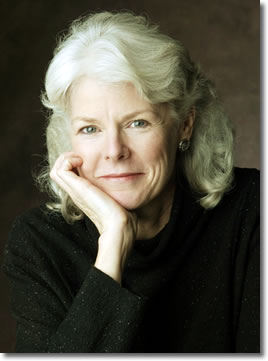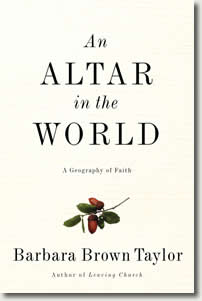An Altar in the World: A Geography of Faith
By Barbara Brown Taylor
Published by HarperOne, 2009
240 pp; $24.99
Read an excerpt from An Altar in the World
Barbara Brown Taylor’s new book promises to do what so many spiritual books promise these days: show us how to encounter the sacred in our everyday lives. But inside An Altar in the World I had the feeling that I was actually seeing the sacred in Taylor’s life. I felt as if I was witnessing how an ordinary life can be sacred.
A couple of years ago, I reviewed Taylor’s first memoir, Leaving Church, on this same site. I wrote:
It can be a joy to be there with her as she remembers a scene, painting a picture with simple lines like, “Since the man was intent on what he was doing, I did not introduce myself right away. Instead I leaned against the counter and watched him work.” At other times, she writes like a poet, and the rhythms of her most introspective prose remind me of Gerard Manley Hopkins: “Sometimes I even keep the Sabbath with a cup of steaming Assam tea on my front porch, watching towhees vie for the highest perch in the poplar tree while God watches me.”
Most poignant in that previous book (her first with a major publisher), were the revelations of an ironic fulfillment of her ordained ministry after her priestly work had ended. Leaving Church tells the story of how Taylor went from nationally respected preacher and pastor, to small town college professor, and how her spiritual life deepened as a result of leaving behind ordained ministry. This priest has found not just solace, but intense meaning (a different sort of priesthood, available to all of us) in the change. “I have never felt more engaged in what I was ordained to do,” she explained in Leaving Church. And here in An Altar in the World, we see it all coming into full bloom.
In An Altar in the World, Taylor lays her cards on the table right at the beginning. She writes:
What is saving my life now is the conviction that there is no spiritual treasure to be found apart from the bodily experiences of human life on earth. My life depends on engaging the most ordinary physical activities with the most exquisite attention I can give them.
Those readers familiar with spiritual books very likely have heard that second sentence in a variety of other ways and places many many times before. But that first sentence—“There is no spiritual treasure to be found apart from the bodily experiences of human life on earth”—stopped me in my tracks. I returned to it again and again, flipping back to that dog-eared page, as I read the rest of this beautiful book.
If Leaving Church was the story of why Taylor left the fulltime work of a clergyperson and found fulfillment doing so, An Altar in the World is her encouragement to others to leave church, as well, if that’s what it takes them to find God. Taylor has sought and found satisfaction of her own spiritual hunger beyond the four walls of churches, out in the creation.
She begins her narrative with a beautiful retelling of the story of the biblical Jacob who rested his head on a stone in the wilderness and then wrestled with an angel all night long. She reminds the reader, as if remembering those days fondly, that Jacob’s experience with God in the desert was in a time when there was no Temple in Jerusalem. “Without one designated place to make their offerings, people were free to see the whole world as an altar.”
An Altar in the World is redolent with detail. Taylor writes so that you, too, can feel God in your hands and feet, in the resounding of your eardrums, in weary feet and knees, in the taste of a tomato, in cool grass and rich soil. Her chapter titles deliver fully on what they promise, such as, “The Practice of Wearing Skin” and “The Practice of Walking on the Earth.”
But it was the chapter on “The Practice of Encountering Others” that was actually my favorite. It isn’t the most sensuous—because people simply aren’t as gorgeous as other parts of the created world—but I think it’s the most important. She shows her church readers (this is where her books have been most popular over the last two decades) how to see all human relationships, not just ones within those four church walls, as vital. Taylor apologizes again and again for offering advice that sounds silly or too simple, but these are actually the most important bits:
“You saved eleven dollars and six cents by shopping at Winn Dixie today,” [the clerk] says, looking right at you. All that is required of you is to look back. Just meet her eyes for a moment when you say, “Thanks.” Sometimes that is all another person needs to know that she has been seen—not the cashier but the person—but even if she does not seem to notice, the encounter has occurred. You noticed, and because you did, neither of you will ever be quite the same again.
I certainly needed to hear this, and am grateful for such ordinary ways and important reminders, that every encounter with another human being is holy.
As I said earlier, I kept flipping back to that arresting sentence (or claim?) of Taylor’s at the outset: “There is no spiritual treasure to be found apart from the bodily experiences of human life on earth.” I must say, in the end, I don’t completely agree. There are activities with God that are barely bodily, involving mostly the brain and the soul (whatever precisely that is). There are times when we “escape” to God in our minds and imaginations, just as, or because, our bodies are engaged in things that we want no part of. I think of the man in the prison weight room, or the elder with early dementia, or my dear friend with advanced M.S. Also, mental prayer is a beautiful practice, as are Raja Yoga, Buddhist insight meditation, and the Ignatian spiritual exercises; most of what happens in these practices goes on in the brain and soul, almost completely ignoring the movements or sensations of the body.
Still, that’s a tiny quibble with a marvelous book. Barbara Brown Taylor’s honesty is so fantastic, and she writes with such wit, that this book is a delight to read and a profound experience, even if you find yourself disagreeing with portions of it.
Barbara Brown Taylor has no interest in selling you anything, and that’s the main reason why this book is so good. She begins a chapter that’s mostly about prayer with this: “I am a failure at prayer. When people ask me about my prayer life, I feel like a bulimic must feel when people ask about her favorite dish.” This is someone you can trust.
Read an excerpt from An Altar in the World
Jon M. Sweeney is the author of several books including The St. Francis Prayer Book, and Cloister Talks: Lessons Learned from My Friends the Monks, coming in May from Brazos. He lives with his two teenage children in Vermont.
